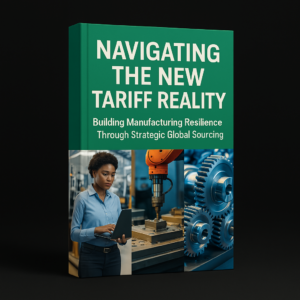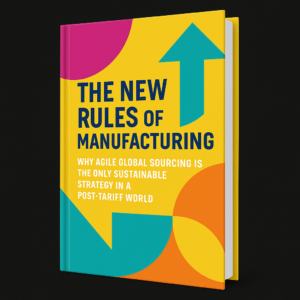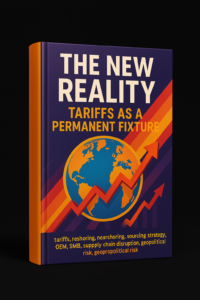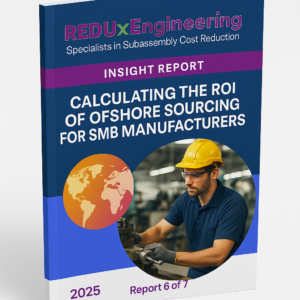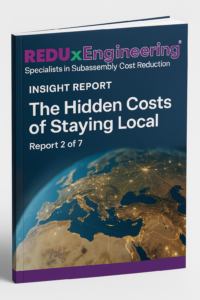
Introduction:
Many manufacturers instinctively prefer local or regional suppliers, assuming that staying close to home means better control or lower risk. However, “staying local” can carry hidden costs that severely impact competitiveness. This report shines a light on those often-overlooked costs: higher unit prices, vulnerability to domestic capacity constraints, and opportunity costs of not exploring global options. In the current environment – characterized by rising input prices and tariffs – the risk of doing nothing (i.e. sticking with the status quo) has grown. We’ll amplify why purely domestic sourcing might actually be the more dangerous choice for your bottom line.
Local Pricing vs. Global Pricing:
The first hidden cost is simply paying more than you need to. As discussed in Report #1, Western-region suppliers generally charge higher prices due to higher labour and overhead. That means if you’re sourcing components exclusively from domestic or nearby vendors, you could be overpaying 20–30% (or more) per part. For example, consider a mid-sized electronics OEM that was purchasing a custom PCB assembly from a local contract manufacturer at $85 per unit. After evaluating offshore alternatives, it became clear the same assembly could be sourced (with equal quality) for about $65 per unit – a 24% cost reduction. In this case, sticking with the local supplier was a hidden $20 penalty on every unit. Across an annual volume of say 50,000 units, that’s $1 million in lost profit. This scenario is not unique; many Western SMEs are sitting on legacy supplier agreements that haven’t been benchmarked globally. The result is a quiet bleed of margin year after year.
Impact of Rising Domestic Costs:
The “hidden cost” problem is growing worse with time. Domestic production costs are climbing due to factors like labour shortages, wage inflation, and expensive energy. In the first quarter of 2025, 76% of manufacturers reported that uncertainty in trade and rising input costs are top concerns. When local suppliers face higher costs, they pass those on to you via price increases. If your bill of materials is sourced entirely in a high-cost country, you’re fully exposed to those inflationary pressures. Moreover, recent geopolitical moves (e.g. new tariffs) mean local suppliers have more pricing power – as everyone rushes to secure domestic capacity, domestic contract manufacturers can command higher prices due to demand. In short, the longer you rely only on local sourcing, the more you may pay as these trends continue. By contrast, companies that diversified their supply base internationally are able to negotiate better pricing or shift orders to lower-cost regions when domestic prices spike.
Capacity Constraints and Delays:
Cost isn’t just a number on a quote – it’s also tied to lead time and reliability, which carry financial consequences. A perhaps counterintuitive “cost” of domestic sourcing emerges when local capacity maxes out. We saw this immediately after the April 2025 U.S. tariff announcement: many American manufacturers rushed to onshore production. But domestic factories simply cannot add capacity overnight. The result? Longer lead times and queue times for orders, even for existing customers. If you’re solely dependent on these domestic suppliers, your production could be delayed, which in turn can delay your product shipments (harming cash flow and sales) or force you into costly expedites/overtime to catch up. Similarly, an overburdened local supplier might cut corners or struggle to meet quality standards – leading to hidden costs in the form of higher defect rates or field failures (and warranty costs). In essence, a strained domestic supply chain can introduce costs of poor service: late deliveries, rush fees, line-down situations, and quality issues all translate to financial pain. Companies that had cultivated offshore backup suppliers, however, found they could shift some production and avoid these delays – a strategic advantage.
Missed Opportunity and Focus:
Another hidden cost of not exploring offshoring is the opportunity cost. Management teams at SMEs have limited bandwidth. Those that proactively examine global sourcing often find cost savings which can be reallocated to strategic initiatives (new product development, marketing, etc.). Those that don’t may end up using precious capital to simply keep up with rising costs, rather than investing in growth. There’s also a focus factor: handling every component in-house or locally can seem simpler, but it means your team is constantly firefighting high costs or supply issues that could be alleviated by a broader sourcing strategy. By not offloading some of that burden, you’re possibly distracting your engineers and supply chain staff from higher-value work (like innovation or process improvement). In economics terms, the “opportunity cost” of staying local could be stagnation – while competitors who globalize parts of their supply chain gain a cost edge and free up resources to leap ahead.
Competitive Disadvantage:
Finally, the aggregate of all these hidden costs manifests as a strategic disadvantage. If your competitors are leveraging offshore suppliers to produce key components at half your cost, they can undercut your prices or enjoy higher margins for reinvestment. In Western Europe, for instance, manufacturers of metal products who insisted on only local EU suppliers found themselves losing bids to rivals who sourced castings from Asia at 40% lower cost. Over time, that kind of cost gap can drive a company out of business. Thus, the cost of inaction could be market share erosion. It might not show up immediately on the balance sheet as a line item, but it shows up in lost deals and shrinking margins.
Conclusion:
Clinging to a purely local manufacturing/sourcing strategy may feel safe, but it is often expensive in ways that aren’t obvious at first. The hidden costs include paying significantly higher unit prices, absorbing the impact of domestic cost inflation, suffering potential delays/quality issues from overtaxed local suppliers, and missing out on opportunities to reinvest savings elsewhere. In a time of global competition and slim margins, these hidden costs of “staying local” can actually pose more risk than a well-managed offshore initiative. The take-home message is not to abandon local suppliers altogether, but to critically evaluate your supply chain. Where are you bleeding margin? Which parts could be sourced elsewhere for less? The next step is to mitigate the perceived risks of offshoring (quality, logistics, etc.), which we will address in subsequent reports. But first, one must acknowledge that the status quo has risks and costs of its own. Only then can a business make an informed decision about balancing local and global sourcing for optimal results.
References (Report 2):
- National Association of Manufacturers – Q1 2025 Manufacturers’ Outlook Survey. 76.2% of manufacturers cited trade uncertainties as a top challenge, and 62.3% cited rising raw material costs, reflecting widespread concern about cost pressures.
- REDUx Engineering Case Data – Example of a PCB assembly cost reduction from $85 (local) to $65 (offshore), a 24% savings achieved with equal quality (Internal project case, 2024).
- REDUx Engineering White Paper (2025) – Discussion of capacity strain when everyone rushes to onshore: lead times become “wildly unpredictable” and contract rates “skyrocket”, illustrating the knock-on costs of purely domestic focus after tariffs.
- Thunder Said Energy (2025) – European manufacturing costs insight: German material+energy costs ~60% above China’s. Highlights how Western-local production can be significantly more expensive, contributing to the hidden cost issue.
- Example Industry Scenario – A Western metalworks company lost business to a competitor using 40% cheaper Asian-sourced castings (hypothetical composite of actual industry reports), underscoring the competitive disadvantage of not offshoring. (Source: Industry trade case studies, 2023–2024.)
#HiddenCosts #GlobalSourcing #ManufacturingStrategy #OffshoringBenefits #SupplyChainRisk #CostCompetitiveness #SMEManufacturing #REDUxEngineering #SourcingOptimization #MarginPressure

